The Great Moon Hoax of 1835
Let’s face it; people fall for hoaxes. Whether it’s sideshow mermaids or Sasquatch footprints or Satanic rings of human traffickers operating out of pizza restaurants, some people will believe anything. It’s even worse when the source of the hoax is a regular, everyday news source. That was the case in August of 1835 when the New York Sun newspaper kicked off an elaborate multi-part hoax that convinced people that cities, rivers, and, well, man-bats, could all be found on The Moon. It’s called the Great Moon Hoax, and this is how they sold it.
A good hoax should contain an element of truth, and the first thing that the initial article did was try to establish credibility by linking it to Sir John Herschel. Herschel was one of those incredibly talented minds who worked across a variety of disciplines. In addition to being an astronomer, a chemist, and a mathematician, he dabbled in botany and photography. He also invented the blueprint (that’s right; blueprints have an inventor, and it’s John Herschel). It ran in the family; his father discovered Uranus, and the younger Herschel named four moons of that planet and seven moons of Saturn. He built his own telescopes, helped figure out the cause of astigmatism, made models of lunar craters, and even co-founded the Royal Astronomical Society (in 1820). With Herschel being such a widely known expert, any discoveries attributed to him would carry an air of truth. The fact is that Herschel had no idea that his name was going to be appropriated for a long con.
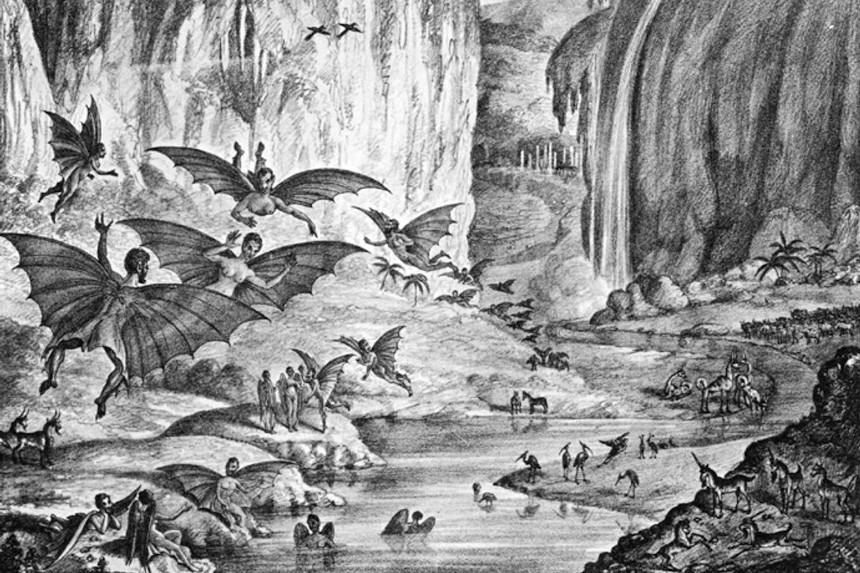
The first hint that the story was coming arrived in the form of an ad that ran on August 21. The ad promised that a purported story from The Edinburgh Courant would run in the Sun. When the first story landed on August 25, it did so with the headline “GREAT ASTRONOMICAL DISCOVERIES LATELY MADE BY SIR JOHN HERSCHEL, L.L.D. F.R.S. &c. At the Cape of Good Hope [From Supplement to the Edinburgh Journal of Science.]” Using the Cape of Good Hope was another clever bit, as that location in South Africa was home to the Royal Observatory, lending some more verisimilitude to the story. The stories themselves carried the byline of Dr. Andrew Grant, who traveled with Herschel and documented his observations. Of course, Grant didn’t exist.
The six articles composed a narrative that had the Moon teeming with life, with some species identical to Earth’s and some vastly different. For every goat or bison, you had unicorns and tailless beavers that walked upright. The article described creatures with a human appearance but bat-like wings, even assigning them the scientific name Vespertilio-homo (Vespertilio is a genus of bats, also known as vesper or frosted bats; vesper itself was a Latin word for “evening”). The man-bats supposedly built temple-like structures on the surface of the Moon. The ability to make such precise discoveries and observations was owed to a new telescope that Herschel had built, which, coincidentally, was destroyed after all of the discoveries were made because sunlight through the powerful lens set the observatory building on fire. Lithographs were created to illustrate the pieces; in some you can see bat-men, unicorns, palm trees, and more, all suggesting a strange world right above us in the sky. The immediate effect for the Sun is that circulation shot up; articles over time have suggested that rumors of impossibly high numbers were exaggerated, but it’s fair to say that the increased numbers allowed the paper to thrive in a tough market, thanks to the Moon articles.
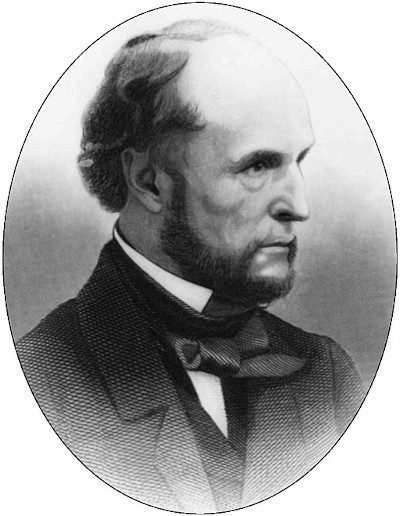
And, of course, it was a total fraud. Though there have been insinuations that other people were involved, the genesis of the Great Moon Hoax leads back to one man, Sun writer Richard Adams Locke. Locke was trying to achieve two goals. The first? Sell more papers. The second? That was deeply rooted in some of the culture of the time. Locke was satirizing scientific and religious personalities who were making grand, unprovable statements about the solar system and presenting them as fact. One example was “Discovery of Many Distinct Traces of Lunar Inhabitants, Especially of One of Their Colossal Buildings,” a paper presented in 1824 by astronomer Franz von Paula Gruithuisen. While Gruithuisen did accurately guess that lunar craters were caused by impacts, his suggestion of cities and jungles on the Moon were shot down by observers with better telescopes.
Another target of Locke was likely Reverend Thomas Dick, author of The Christian Philosopher. While Dick lobbied for the idea that science and religion could peacefully co-exist and advocated the abolition of slavery, he also made outlandish guesses as to the population of the solar system. He claimed to have mathematically determined that 21.9 trillion people lived in the solar system, and that the Moon had a population in excess of 4 billion; his basis for this was simply applying the population density of England to the projected sizes of the other planets. It should be noted that Dick was from Scotland, and that the original teaser ad suggesting that the Moon story originated in The Edinburg Courant may have been a sly joke.
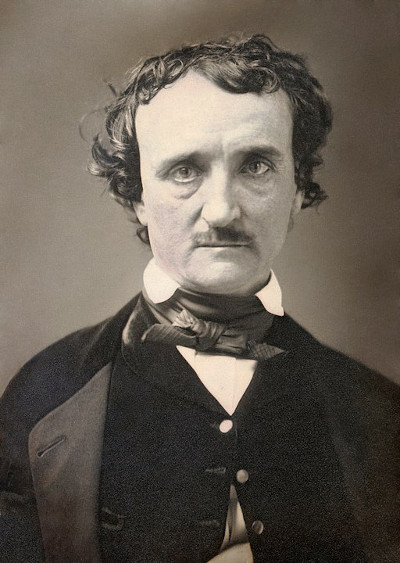
As the “Great Moon Hoax” spread, some people took it seriously, and some people took it for a joke. When it was revealed as a hoax several weeks later, the paper never reprinted a retraction. Sir Herschel found the whole thing quite funny at first, but later grew tired of having to answer questions about it. Someone who wasn’t amused by the whole affair was Edgar Allan Poe. That’s because Poe claimed that the Moon Hoax story wasn’t just an invention; it was plagiarism. His allegation was based on the fact that he’d written a very similar type of story (fictional, for his part) that ran two months earlier in the Southern Literary Messenger. The title was “The Unparalleled Adventure of One Hans Pfaall,” and the editor of the piece was . . . Richard Adams Locke.
Poe’s story was supposed to be — wait for it — a hoax itself. It was also supposed to run in multiple installments. The tale centers on a man who goes to the Moon in a balloon with a device that manufactures breathable air. However, Poe discontinued the story after having his thunder stolen by the Sun pieces. And then he planned his revenge (he was, after all, Edgar Allen Poe). In 1844, Poe published a story reporting that balloonist Monck Mason had crossed the Atlantic in three days using a gas balloon. The story was a sensation, but it was deflated two days later when it was revealed that Poe’s story was itself a hoax, and that he’d done it to burn the Sun and his editor on the balloon story . . . Richard Adams Locke. Angry that the Sun had profited from his ideas but he never saw a cent, Poe took the opportunity nine years later to make the paper and Locke both regret it. Matthew Goodman’s 2008 book The Sun and The Moon relates the tale behind Poe, Locke, the Sun articles, and Poe’s piece, which is now known as “The Balloon-Hoax.” One lasting effect of the Moon/Balloon back-and-forth was that it inspired Jules Verne twice. The French novelist, widely considered one of the most important figures in science fiction, mentions both the Great Moon Hoax and Poe’s original story in 1865’s From the Earth to the Moon. Additionally, Poe’s balloon story piqued his interest in that method of travel, something that he includes in both Around the World in 80 Days and Five Weeks in a Balloon.
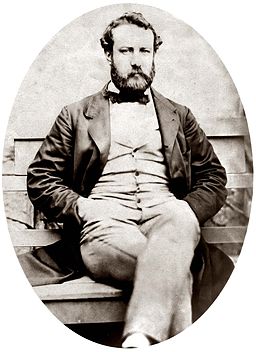
Looking back, the Great Moon Hoax manages to be both believable and unbelievable. It seems odd that a writer would put the reputation of their paper at risk to sell copies based on a completely fictional story. In the case of Locke and the Sun, the gamble worked. You could say that it’s odd that people believed it at all, but history has shown that people are willing to believe quite a lot, even in the face of significant evidence. It’s funny to think that the Sun Moon battle would be so relatable to our current social and technological issues, but Jules Verne probably wouldn’t be surprised at all.
Featured image: Wikimedia Commons / Public Domain in the United States
Movies for the Rest of Us with Bill Newcott: Our Favorite Movie Moons
It’s been 50 years since Neil Armstrong landed on the moon, and even longer since Hollywood’s love affair with the lunar landscape. Here are Bill Newcott’s favorite scenes featuring moons in the movies.
The Moon Man Down the Street
The moonwalker lives in a pale-blue house at the end of a long driveway. Its defining feature is a steeply pitched entryway roof that points unambiguously to the heavens.
I ask several employees at the CVS a couple of blocks from the house if they know Edgar Mitchell. Not a blink of recognition, except for a 20-something girl in the pharmacy department. “Oh, sure — I think that’s a dress shop up the way,” she says.
Imagine that. Edgar Mitchell — the sixth human to walk on the surface of the moon, once widely feted by grateful heads of state for his historic achievement — is now a nearly anonymous 84-year-old with three dogs, a Toyota SUV, and a part-time assistant. He lives on five unmanicured acres in a South Florida suburb.
For the most part, he seems OK with being an ordinary old Earthling, his spaceman days long past. Test pilots tend to be both fatalistic and realistic in that way. As we sit across from each other in his living room, he sums up his extraordinary NASA career in three words: “I was competent.” A moment later, speaking of his Apollo 14 moon lander named Antares, he adds, “I had a good machine.”
Mitchell’s moment in the moonlight, if you will, occurred 44 years ago. He and fellow astronaut Alan Shepard landed in the Fra Mauro region, where they spent 33 hours conducting scientific experiments (and clowning around a bit on camera). Mitchell still holds the record for the longest walk on the moon. He doesn’t boast about it, but he’s hung a document that certifies the trek.
It is in the modern-day DNA of America to manufacture heroes, to nourish them and genuflect before them. That was somewhat less true on the afternoon of January 31, 1971, when Mitchell, strapped into a cramped command module atop 960,000 gallons of rocket fuel, blasted off before a worldwide TV audience. Our cultural perspective has since shifted. Today, we call first responders our national heroes; LeBron James is a hero to millions of kids; hell, even the Congressional Sergeant at Arms may be a heroic figure to ambitious, first-year security officers everywhere. But their enduring light will be but a flicker compared to Ed Mitchell’s death-defying achievement. Mitchell is one of only eight living men in the entire arc of human civilization to have visited our satellite moon — the moon! His feat is literally otherworldly.
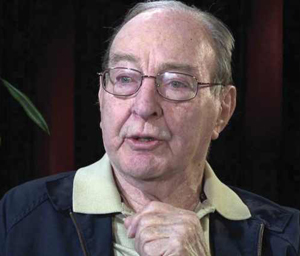
And yet the brain-bending truth is that these days Mitchell is just another suspenders-wearing retiree who has gently touched down in the Florida sunshine. He meditates every morning, sometimes listens to honky-tonk music, plays sudoku “with pleasure,” and, he insists, seldom contemplates the moon.
Visitors, such as me, will sometimes get a tour of what he calls “the museum” — that is, the entirety of his home — which is bursting with astronaut memorabilia. So, while Mitchell insists he never stares at the moon, he doesn’t need to. It stares back at him from every inch of his pad. The most remarkable artifact of all is nearly lost among the clutter of his office: the actual control stick from the Antares lander, wires sprouting from its bottom.
When Mitchell left NASA in 1972, he was awarded a standard pension. Hardly enough money to live on. It’s not widely known, but astronauts receive no special compensation for their risk-taking. Demeaning though it was, Mitchell briefly accepted a job at the National Enquirer, which required chiefly that he introduce its owner to a succession of psychics, whom he knew because of his interest in parapsychology. It was a mistake, he admits. “But I had to make a living.” Again, imagine that.
In the years since, Mitchell has consulted on several documentaries and Hollywood films (Apollo 13, for example, which in real life he helped rescue from disaster). On others’ recommendations, he watched bits of the hit 2013 movie Gravity. “Not impressed,” he says to me, twice.
It pleases him that nowadays he is known for something other than bounding along on moon dust. He is among the high priests of quantum physics and is the founder of the Institute of Noetic Sciences, which explores the nature of consciousness. If you’re willing to pay, he’ll join you in a Skype conversation on these topics. “I’m a cosmologist, looking for the answers to the deep questions about our planet,” he says. “Returning from the moon, seeing the heavens from that perspective, I had a sense of wonder and joy and beauty.”
The moonwalker down the road, who neither seeks nor receives much hero worship, is concerned about the future of our planet. “We are consuming at an alarming rate,” Edgar Mitchell tells me. “We won’t endure another hundred years,” And so? “We have to get some of our people to go elsewhere. Mars.”
—
Edgar Mitchell passed away at age 85 on February 4, 2016, one day before the 45th anniversary of his moon landing.